Archived Mold Remediation Blog Posts
Ways to Prevent Mold Damage to Your Home
10/3/2024 (Permalink)
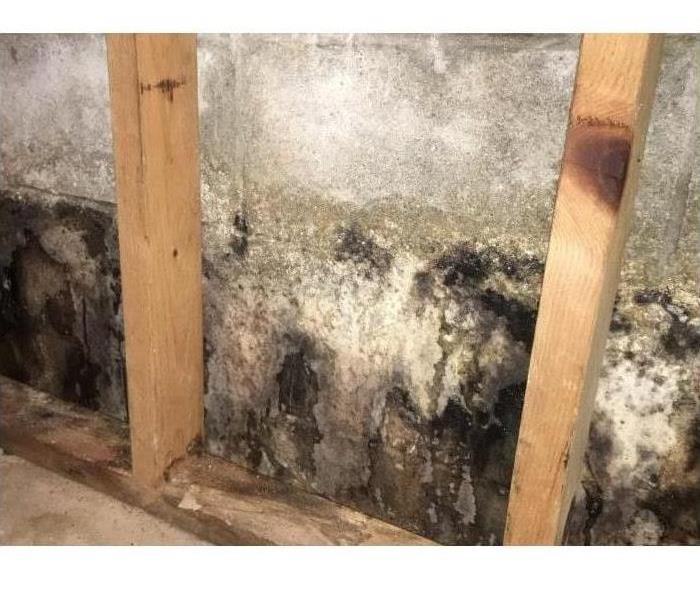 Mold growth CAN be prevented if you take the appropriate steps...
Mold growth CAN be prevented if you take the appropriate steps...
Mold is everywhere – indoors, outdoors, and even on the evening news! There is a lot of concern over mold in our environment, and how it can impact us and our families. Here are the top 10 things the EPA feels everyone should know about mold:
- There is no practical way to eliminate all mold and mold spores in the indoor environment; the way to control indoor mold growth is to control moisture.
- If mold is a problem in your home or school, you must clean up the mold and eliminate sources of moisture.
- Fix the source of the water problem or leak to prevent mold growth.
- Reduce indoor humidity (to 30-60%) to decrease mold growth by:
- Venting bathrooms, dryers and other moisture-generating sources to the outside
- Using air conditioners and de-humidifiers
- Increasing ventilation
- Using exhaust fans whenever cooking, dishwashing and cleaning
- Clean and dry any damp or wet building materials and furnishings within 24-48 hours to prevent mold growth.
- Clean mold off hard surfaces with water and detergent, and dry completely. Absorbent materials such as ceiling tiles, that are moldy, may need to be replaced.
- Prevent condensation: Reduce the potential for condensation on cold surfaces (i.e., windows, piping, exterior walls, roof, or floors) by adding insulation.
- In areas where there is a perpetual moisture problem, do not install carpeting (i.e., by drinking fountains, by classroom sinks, or on concrete floors with leaks or frequent condensation).
- Molds can be found almost anywhere; they can grow on virtually any substance, providing moisture is present. There are molds that can grow on wood, paper, carpet, and foods.
If you do see, or even suspect mold, in your home, do not hesitate to call your Mold Remediation Specialists at SERVPRO® today at 541-745-2097!
Mold is Preventable
5/8/2024 (Permalink)
 Mold can grow almost anywhere - but it can also be easily prevented with proper care.
Mold can grow almost anywhere - but it can also be easily prevented with proper care.
Mold is preventative
When a residential or commercial property suffers a water damage disaster, mold spores begin to appear within 48-72 hours. SERVPRO® has the training and experience to properly execute the resolution of mold growth. In the case of suspected mold growth in your residential or commercial property SERVPRO® Team McGinnis West can inspect, determine the cause and remediate your property.
According to the EPA, here are the top 9 things you should know about mold/growth.
- Learn to control mold growth indoors. Maintain a low humidity level, especially high moisture in the bathroom and kitchen.
- Immediately clean and eliminate the source of mold. If you are unable to or unsure, call in the professionals.
- Repair or replace the source of water leak or problem.
- Maintaining bathroom vents, dryers, and range hoods will lessen the possibility of mold growth. Be aware during hot weather when running your air conditioner units that there is no water spillage.
- Immediately dry any water damaged surface or materials.
- Use a combination of water and detergent to clean mold off of surfaces. This is less toxic than bleach and will not cause further damage to the surface.
- Maintaining insulation properly (i.e. window sills, door jams, crawlspaces, attics) will reduce the collection of condensation.
- Carpet should never be installed in bathrooms or kitchens due to the high moisture and humidity.
- Inspect surfaces and object that have set in water damage, mold can grow on any surface including, but not limited to, cardboard, furniture, water fountains, and food.
If you have questions or need help with your Oregon residential or commercial property, you can call SERVPRO® Team McGinnis anytime at 541-745-2097.
How to help prevent mold growth in your home
10/6/2023 (Permalink)
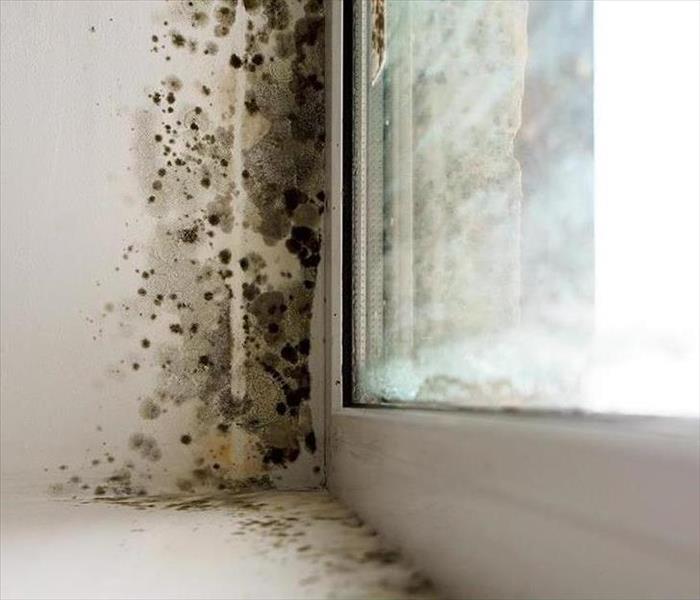 Taking steps to help prevent mold growth can save you money down the road!
Taking steps to help prevent mold growth can save you money down the road!
Here are some ways to keep your home safe from mold damages and prevent further damage. Brought to you by SERVPRO® of Benton and Linn County.
- Eliminate Clutter
Clutter blocks airflow and prevents your HVAC system from circulating air. Furniture and curtains that block supply grilles cause condensation. All this moisture creates microclimates in your home that welcome mold growth. Push furniture away from vents and grilles to keep air circulating. On humid, still days, run a couple of fans to keep air moving.
- Shut Windows and Doors When AC Is On
When you open windows and doors, you let air conditioning escape, waste money, and invite humid air into your cooler home. This causes condensation, which mold loves. So keep doors and windows shut when the AC is humming. Also, maintain your home at around 80 degrees when you’re on vacation or at work. Too often, we bump the thermostat up to 85 degrees, or turn off the AC when we’re away. This raises temperature and humidity, which creates the ideal home for mold.
- Monitor Humidity
An indoor humidity monitor will help you keep track of moisture levels that, ideally, fall between 35% and 50% relative humidity; in very humid climates, at the height of summer, you may have to live with readings closer to 55%. But if you reach 60% relative humidity, it’s time to look for the source of the added moisture; above 70% relative humidity, certain species of mold can begin growing.
- Water Damage
If left untreated can cause major damage in your home including serious Mold Growth.
water damage whether it is a clean water break, a leaking washing machine, or a sewage leak, it is still very important to address it quickly before further damage occurs. SERVPRO is equipped to handle whatever the situation, whether large or small.
Permanent damage happens quickly, from wood surfaces deteriorating, carpet delaminating, or mold beginning to appear because of the moist conditions. This is why it is so important to act quickly.
If your home is experiencing Mold give SERVPRO® of Benton and Linn County a call today at (541)745-2097
Mold: The Unwanted Guest in Your Home
5/4/2023 (Permalink)
Mold growth is a common problem that many homeowners face. Not only is it unsightly and can cause damage to your property, but it can also be hazardous to your health.
If you have discovered mold in your home, call SERVPRO!
One of the most critical factors when it comes to mold remediation is response time. The longer you wait to address the issue, the more extensive the mold growth can become!
Mold remediation is a complex process that requires specialized training and expertise. SERVPRO's professionals are trained and certified in mold remediation and removal. They use advanced equipment and techniques to identify and remove mold from your home, ensuring that it is done safely and effectively. They can handle everything from air quality testing to containment, mold removal, and even reconstruction if necessary.
SERVPRO has a proven track record of success in mold remediation. They have restored countless homes and businesses that have suffered from mold growth.
Contact SERVPRO today to learn more about how they can help you get your home back to a safe and healthy state after mold growth.
Mold, Mold, Mold!
10/4/2022 (Permalink)
Mold can happen to anyone at any time, in their home or business. Mold can be in places you never go, like in your attic or even in places you go often, like your bathroom.
It’s best to get things checked out after being saturated, wet or exposed to moisture to look for mold growth. Mold is almost always a problem before it is even discovered and can start to grow after 24 to 48 hours.
SERVPRO is here 24/7/365 to inspect, clean, treat, and remove mold. SERVPRO also handles water damage the right way, the first time, to make sure everything gets properly dried and treated to prevent mold.
If you suspect mold in your home or business, or have any kind of water damage, it can lead to having mold so call SERVPRO
Mold Creeps In
10/14/2021 (Permalink)
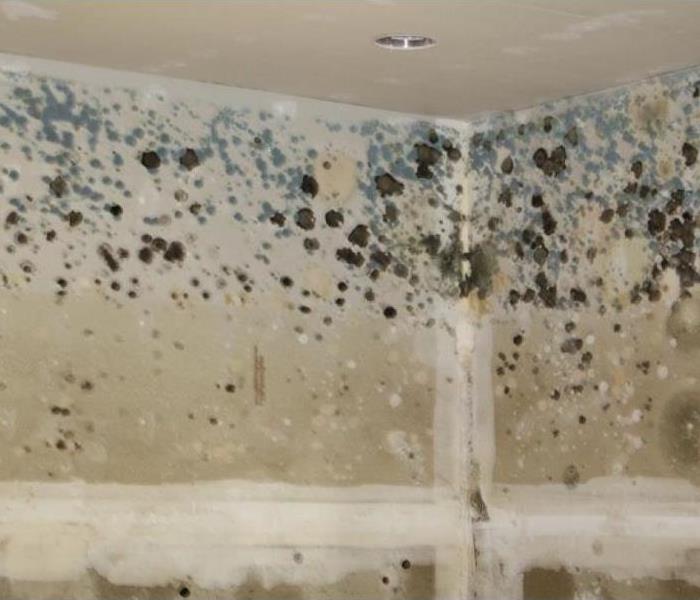 Know the depth of your Mold!
Know the depth of your Mold!
Lets talk Mold.
Mold is a type of fungus that consists of small organisms. In small amounts, mold spores are usually harmless, but when they land on a damp spot in your home, they can start to grow. When mold is growing on a surface, spores can be released into the air where they can be easily inhaled.
Some restoration companies advertise “mold removal” and may even guarantee to remove all mold. This is a fallacy because removing all mold from a house or business is impossible; microscopic mold spores exist almost everywhere, both indoors and outdoors. Here are the facts:
- Mold is present almost everywhere, indoors and outdoors.
- Mold spores are microscopic and float along in the air and may enter your home through windows, doors, or AC/heating systems or even hitch a ride indoors on your clothing or a pet.
- Mold spores thrive on moisture. Mold spores can quickly grow into colonies when exposed to water. These colonies may produce health effects.
- Before mold remediation can begin, any sources of water or moisture must be addressed. Otherwise, the mold may return.
- Mold often produces a strong, musty odor and can lead you to possible mold problem areas.
- Even higher-than-normal indoor humidity can support mold growth. Keep indoor humidity below 45 percent.
Call us today if you feel you have a Mold problem!
Mold, Don't let it Grow!
10/29/2020 (Permalink)
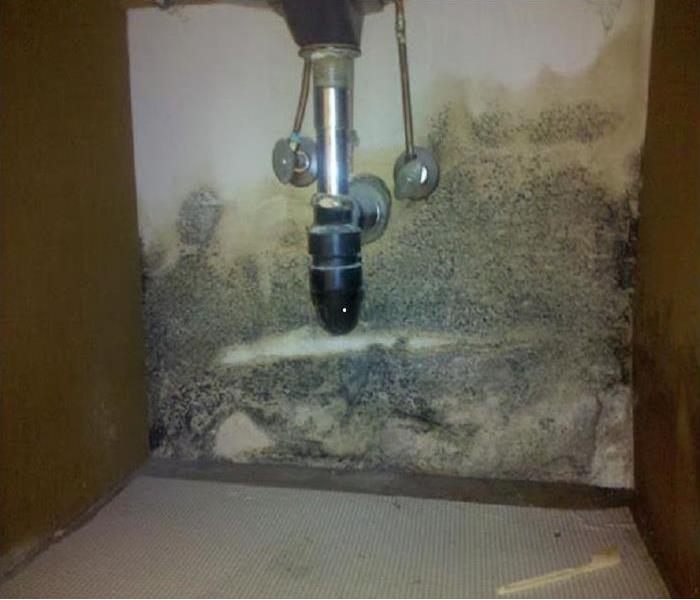 Don't forget to look under your sinks!
Don't forget to look under your sinks!
As we start coming into the cold rainy season here in Oregon, moisture can start to build up in areas of your home that have water intrusion. Some examples of water intrusions are from storm damage, plumbing or equipment failures, long-standing leaks and poor humidity control. If these issues do not get taken care of in a timely manner, they lead to mold growth. While it is normal for a small amount of mold spores to be present in most environments, once it starts spreading and multiplying, it becomes a huge health risk. The mold typically latches onto organic materials in your home such as wood, paper, drywall and insulation. If your home has excessive humidity, a strong musty odor, or visible mold, call SERVPRO! Our Franchise has trained professionals in mold remediation who can safely restore your home to preloss condition.
How to prevent mold in your home
10/31/2019 (Permalink)
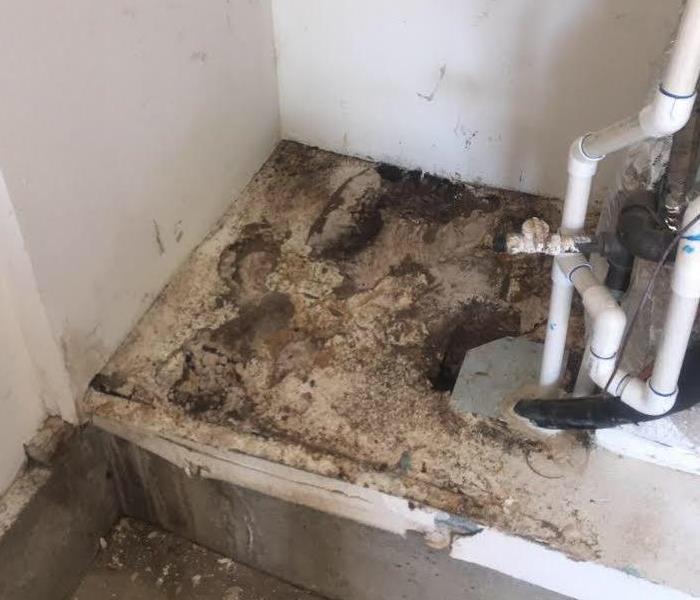 In this picture a water heater had been leaking over a period of time causing massive mold growth and damage to the drywall.
In this picture a water heater had been leaking over a period of time causing massive mold growth and damage to the drywall.
Mold!
Most hear the word and think ‘YUCK!’. It’s easy to forget that mold can ever be a good thing! We use it to make some cheeses and even penicillin. It is one of nature’s beneficial decomposers. Mold can, and does, grow anywhere – as anyone in Oregon knows only too well! But, it’s easy to forget any of the good reasons for mold when we find it in our homes. Decomposing our carpets, or drywall, or floorboards…
To flip the old adage, a good defense against mold is a good offense. Its best to prevent mold growth before it becomes a problem. And the best offense is: moisture control. Easier said than done, here in Oregon, I know! Mold can be costly to fix, but relatively easy to prevent. Here are a few ways you can help curb indoor moisture issues, and the mold that thrives on it.
- Identify potential problem areas in your house.While you cannot ‘mold-proof’ your home, you can take measures to make it more ‘mold-resistant’. Inspect your home for problem areas: does your basement flood? Do you experience condensation on windows? Invest a little time and money now to address such issues.
- Dry wet areas immediately. Mold needs moisture to grow – taking a moment to wipe up any standing/pooling water can prevent mold growth.
- Proper Ventilation.Every day household activities can encourage mold growth: cooking, showering, and doing laundry…making sure your kitchen, bathrooms and laundry room are properly ventilated can help keep moisture down, and thus keep mold from taking root.
- Utilize ‘mold-resistant’ products in your home. Whether building a new home, or renovating an older home, consider using mold-resistant drywall or sheetrock in high-humidity rooms.
- Clean or repair gutters.A mold problem may be a simple matter of a roof that is leaking due to a clogged or damaged gutter. Cleaning your gutters regularly and having them inspected for damage can help prevent water from invading home.
These are just a few of the often simple measures you can take, as a homeowner, to help protect your property, and your family against the potentially harmful effects of mold in your home. If you do suspect or find mold in your home, call your Mold Remediation Specialists at SERVPRO.
Drying your home after a water loss, and why is important.
12/11/2018 (Permalink)
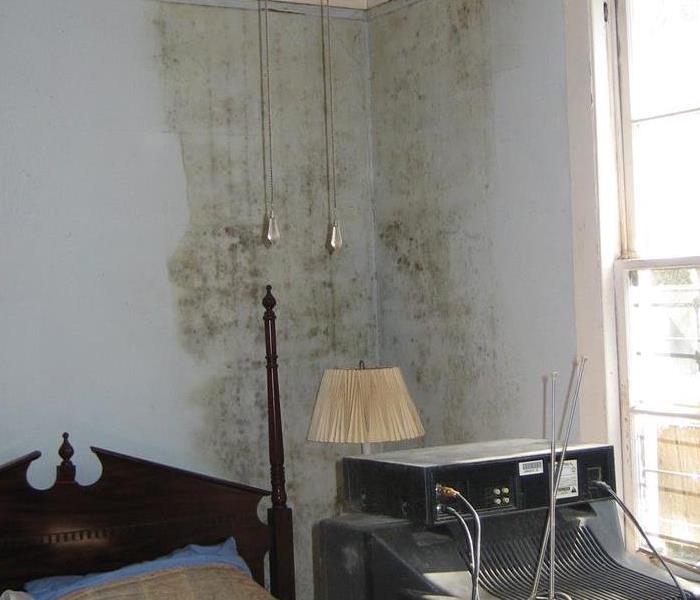 Mold will happen so quick if your home is not properly dried.
Mold will happen so quick if your home is not properly dried.
The top things 3 things to remember when dealing with a water loss are:
- Know what kind of water loss it was: Clean water (CAT 1) = Pipe or rain water.
Gray water (CAT 2) = Toilet water, Kitchen sink pipe.
Black Water (CAT 3) = Sewer water.
CAT 2 and 3 are the most harmful to your family. The water is contaminated and will cause problems.
- Make sure you investigate all the damage.
- Establish proper air flow, and keep windows closed when drying.
Mold can grow so quick if the moister is not addressed right away. SERVPRO can help with drying out your home we have equipment that will dry you home quickly. If your home is experiencing this problem SERVPRO can fit it.
Signs to watch for MOLD in your home
12/6/2018 (Permalink)
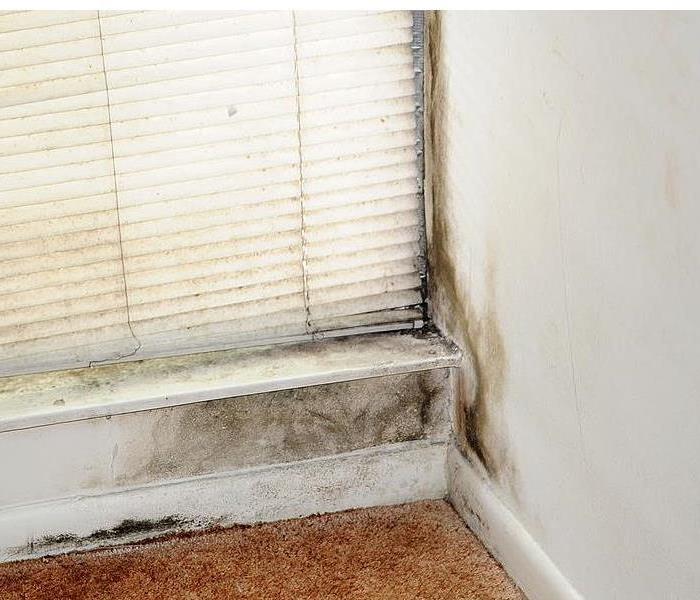 Mold Growth
Mold Growth
The top 6 warning signs of Mold in your home are:
- Smelling a musty smell “Mold Odor”.
- Seeing Mold growth “Black and Green splatters”.
- Water Problems
- Bubbling paint/ wall paper
- Water stains
- Damp materials like “drywall, flooring, cabinets, and ceiling tiles”
- Water Leaks that are not addressed right way. Growth can happen so fast.
- Home has flooded in the past.
- If the home was not properly dried and cleaned. Growth with start right away.
- Condensation
- If your home has a moister around window, and under cabinets were your water pipes are. Mold loves moister!
We here at SERVPRO of Benton County work with cleaning and removing mold on a daily bias. If you need help with a Mold problem, let us help you. “We make it like it never happened.”
Mold: The pink stuff in the bottom of your shower is actually mold
11/6/2018 (Permalink)
 Courtesy of Google Images
Courtesy of Google Images
When you picture mold, most people immediately think of black mold, the scary stuff.
However, there are all kinds of mold, from bread mold that was used to make vaccinations, to black mold.
But did you know, that the pink stuff in the bottom of your shower is a form of mold? When water pools in an environment like the shower, it grows a pink mold called “Serratia Marcescens” which is a bacteria that feeds off soap scum.
It tends to grow on the floor of the shower, and in crevices like where grouting is.
Ways that you can clean it is easy, according to the cleaning company “The Maids”, the easiest way to kill it is by placing white distilled vinegar into a spray bottle, spraying it onto the mold, and letting it sit an hour before washing it off.
According to “The Maids”, vinegar kills up to 82% of species of mold, which can be useful in smaller jobs like light mold removal from a shower.
The 10 Things You Need to Know About Mold
5/7/2018 (Permalink)
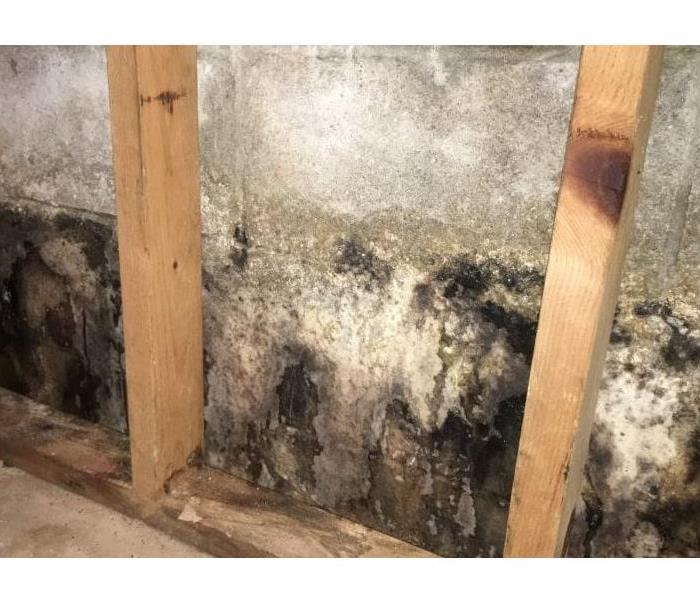 If you see, or even suspect mold, contact the Professionals at SERVPRO today!!
If you see, or even suspect mold, contact the Professionals at SERVPRO today!!
Mold is everywhere – indoors, outdoors, and even on the evening news! There is a lot of concern over mold in our environment, and how it can impact us and our families. Here are the top 10 things the EPA feels everyone should know about mold:
- There is no practical way to eliminate all mold and mold spores in the indoor environment; the way to control indoor mold growth is to control moisture.
- If mold is a problem in your home or school, you must clean up the mold and eliminate sources of moisture.
- Fix the source of the water problem or leak to prevent mold growth.
- Reduce indoor humidity (to 30-60%) to decrease mold growth by:
- Venting bathrooms, dryers and other moisture-generating sources to the outside
- Using air conditioners and de-humidifiers
- Increasing ventilation
- Using exhaust fans whenever cooking, dishwashing and cleaning
- Clean and dry any damp or wet building materials and furnishings within 24-48 hours to prevent mold growth.
- Clean mold off hard surfaces with water and detergent, and dry completely. Absorbent materials such as ceiling tiles, that are moldy, may need to be replaced.
- Prevent condensation: Reduce the potential for condensation on cold surfaces (i.e., windows, piping, exterior walls, roof, or floors) by adding insulation.
- In areas where there is a perpetual moisture problem, do not install carpeting (i.e., by drinking fountains, by classroom sinks, or on concrete floors with leaks or frequent condensation).
- Molds can be found almost anywhere; they can grow on virtually any substance, providing moisture is present. There are molds that can grow on wood, paper, carpet, and foods.
- Potential health effects and symptoms associated with mold exposures include allergic reactions, asthma and other respiratory complaints
If you do see, or even suspect mold, in your home, do not hesitate to call your Mold Remediation Specialists at SERVPRO today!
Is it Black Mold???
5/1/2018 (Permalink)
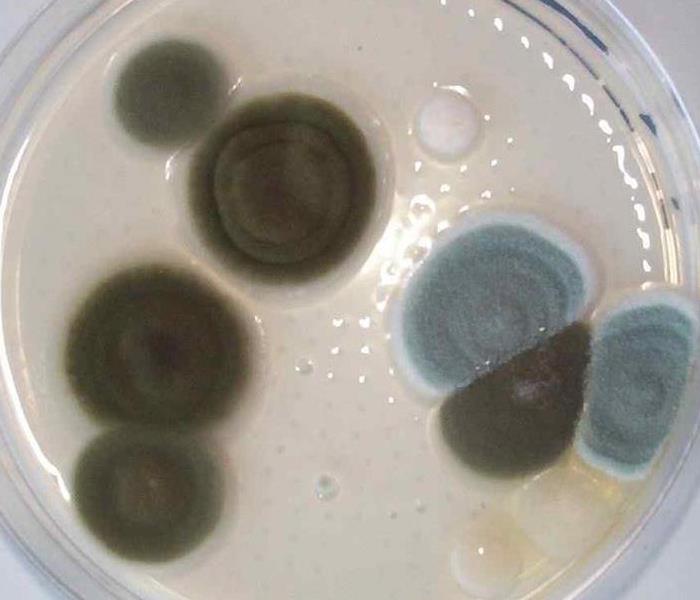 Ask for a professional mold inspection to correctly identify the mold in your home
Ask for a professional mold inspection to correctly identify the mold in your home
Its what everyone fears, Stachybotrys chartarum is the type of mold often called “black mold” or “toxic mold”. Sensational news reports warn about the dangers of black mold and these stories can be alarming and confusing. Any mold in your home should be treated with caution – stay out of affected areas and don’t touch or disturb the mold.
Please refer to our Mold Damage Tips to learn more about mold and what to do until help arrives.
How Do I Tell If It’s Black Mold?
Since many types of mold can produce allergens and irritants, you should contact a qualified mold remediation company regardless of the color or type of mold. In many instances, multiple types of mold can exist in the same house or structure. If you suspect that you have a mold problem, contact a SERVPRO Mold Remediation Professional immediately.
If you see signs of mold, call us today at, 541-745-2097
Understanding Mold
When water intrudes into your property, mold growth can start in as little as 48 hours. Consider the following mold facts:
- Mold is present almost everywhere, indoors and outdoors.
- Mold spores are microscopic, float along in the air, and may enter your home through windows, doors, or AC/heating systems or even hitch a ride indoors on your clothing or a pet.
- Mold spores thrive on moisture. Mold spores can quickly grow into colonies when exposed to water. These colonies may produce toxins harmful to humans and pets.
- Before mold remediation can begin, any sources of water or moisture must be addressed. Otherwise the mold may return.
- Mold often produces a strong, musty odor, and that odor can lead you to possible mold problem areas.
- Even higher-than-normal indoor humidity can support mold growth. Keep indoor humidity below 45 percent.
Preventing Mold in Your Bathroom
4/5/2018 (Permalink)
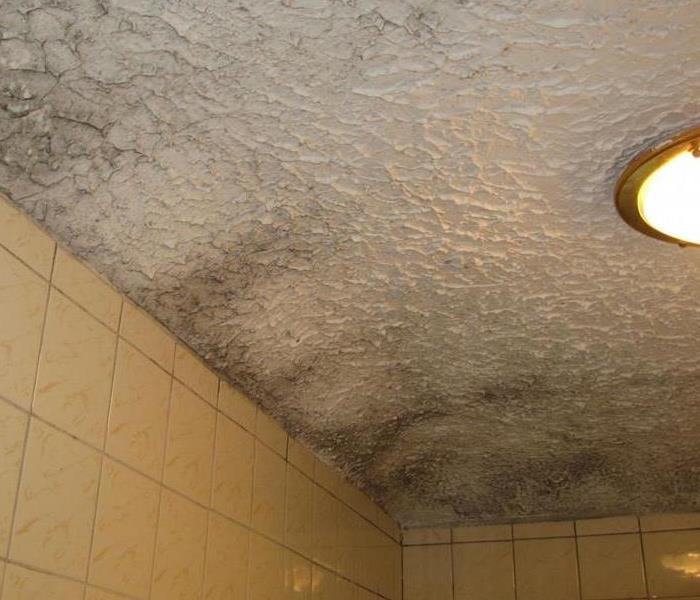 Prevention is key in keeping mold out of your bathroom
Prevention is key in keeping mold out of your bathroom
One of the most common places mold grows in our homes is in the bathroom. This room is usually damp, exposed to high-humidity, dark, and often neglected. Investing a small amount of time and money now, can help prevent a large amount of time and dollars down the road. Here are a few simple suggestions to help prevent mold growth in your home:
Choose Mildrew-Resistant paint After a nice hot shower, our bathroom walls absorb the lingering moisture, which can invite the growth of moisture. Selecting a paint that resists mildew will give your walls an extra level of protection.
Proper Ventilation Mildew loves moisture. To help eliminate excessive moisture, be sure to run your exhaust fan during your shower, and for about 30 minutes after. This helps ensure the walls and ceiling will dry properly.
Let the light shine A surprisingly simple step, that is easily overlooked, is to let in the light. Mildew loves darkness, so leaving the overhead light on, or better yet, allowing natural light to enter the room through a window will actually help keep that fungus at bay.
Mop up water Nip mildew in the bud by getting rid of excess water as soon as possible. Keep a squeegee near the shower to quickly take care of the shower walls, and mop up any puddle on the floor.
Keep it clean Simply taking the time to give your bathroom a good cleaning on a regular basis can help prevent mildew from gaining any ground in your bathroom. Spending 20 minutes a week to wipe down and disinfect can save you save you a lot of time and headaches down the road.
Prevention is the key when it comes to mold in your home. But if you do see or smell mold, do not hesitate to give SERVPRO a call today! Our Mold Remediation Specialists are ready to respond, and make it ‘’like it never even happened”.
Preventing Mold in Your Home
2/20/2018 (Permalink)
Mold. Most hear the word and think ‘YUCK!’. It’s easy to forget that mold can ever be a good thing! We use it to make some cheeses and even penicillin. It is one of nature’s beneficial decomposers. Mold can, and does, grow anywhere – as anyone in Oregon knows only too well! But, it’s easy to forget any of the good reasons for mold when we find it in our homes. Decomposing our carpets, or drywall, or floorboards…
To flip the old adage, a good defense against mold is a good offense. Its best to prevent mold growth before it becomes a problem. And the best offense is: moisture control. Easier said than done, here in Oregon, I know! Mold can be costly to fix, but relatively easy to prevent. Here are a few ways you can help curb indoor moisture issues, and the mold that thrives on it.
- Identify potential problem areas in your house. While you cannot ‘mold-proof’ your home, you can take measures to make it more ‘mold-resistant’. Inspect your home for problem areas: does your basement flood? Do you experience condensation on windows? Invest a little time and money now to address such issues.
- Dry wet areas immediately. Mold needs moisture to grow – taking a moment to wipe up any standing/pooling water can prevent mold growth.
- Proper Ventilation. Every day household activities can encourage mold growth: cooking, showering, and doing laundry…making sure your kitchen, bathrooms and laundry room are properly ventilated can help keep moisture down, and thus keep mold from taking root.
- Utilize ‘mold-resistant’ products in your home. Whether building a new home, or renovating an older home, consider using mold-resistant drywall or sheetrock in high-humidity rooms.
- Clean or repair gutters. A mold problem may be a simple matter of a roof that is leaking due to a clogged or damaged gutter. Cleaning your gutters regularly and having them inspected for damage can help prevent water from invading home.
These are just a few of the often simple measures you can take, as a homeowner, to help protect your property, and your family against the potentially harmful effects of mold in your home. If you do suspect or find mold in your home, call your Mold Remediation Specialists at SERVPRO.
Detecting Mold in your home
12/11/2017 (Permalink)
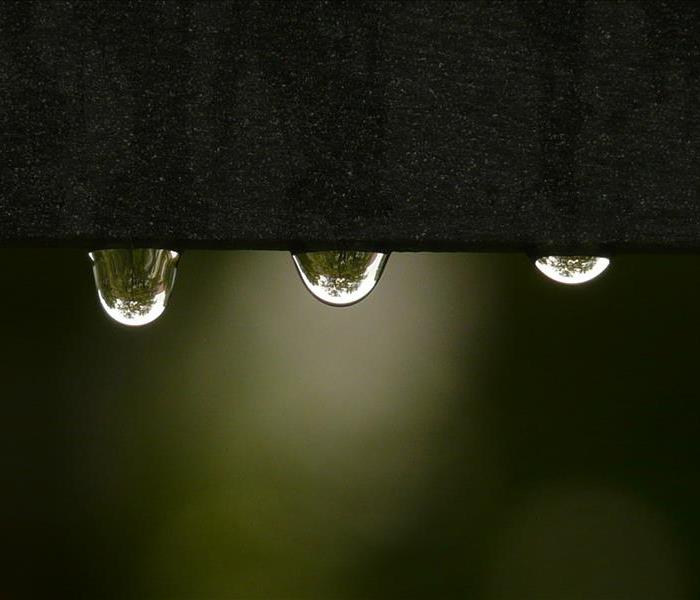 Learn more about what to look for in your home concerning mold
Learn more about what to look for in your home concerning mold
Quite often, constantly smelling a musty odor could be the one of the only mold signs that your home has. If you can smell mold there is likely mold under something or mold in something. If there is a funky smell that you cant seem to get to the bottom of, it may be mold lurking somewhere hard to reach. SERVPRO can help find the mold and get rid of it in a safe and healthy way.
Mold can often present itself in the form of allergies. If you feel better when you’re away from home, but notice your allergies tend to flare up whenever you’re at home that can mean that you have mold somewhere. Mold can cause health effects for most individuals. Mold can be behind walls, in the basement, under the carpet, in damp areas of the house, surrounding roof leaks or in an area that experiences high humidity. If you think you might have a mold problem in your home, give SERVPRO a call. We can find the source of the mold damage and locate any water damage or leaks that are causing the mold. We will repair the problem and have your home back to preloss condition in no time.
Why drying out your home is important
12/11/2017 (Permalink)
 Commercial drying your home and why it is important.
Commercial drying your home and why it is important.
The longer water and moist air remain in your home following a storm, the greater the likelihood of increased damage to the house and health risks to your family. Within 48 hours, mold, mildew and fungus can begin to grow, producing a lasting musty odor. In addition, water can warp and rot wood, disintegrate wallboard, ruin most types of insulation, compromise electrical wiring and more.
This is why SERVPRO can help you dry out your home after water damage to help you prevent mold. We have commercial drying machines that will dry out your home in no time.
Main areas we aim to dry ensure are dry are walls and flooring, especially carpet flooring. This is a place that mold will thrive.
Here are some helpful tips to handle moisture until we get there.
During the day, when the weather is dry – open all windows and doors to exchange damp interior air for drier outdoor air. Close them at night or when outdoor humidity rises.
Also, open closet doors and drawers. If drawers are hard to pull open because of swelling, remove the backs from cabinets to increase air circulation and allow access.






 24/7 Emergency Service
24/7 Emergency Service













